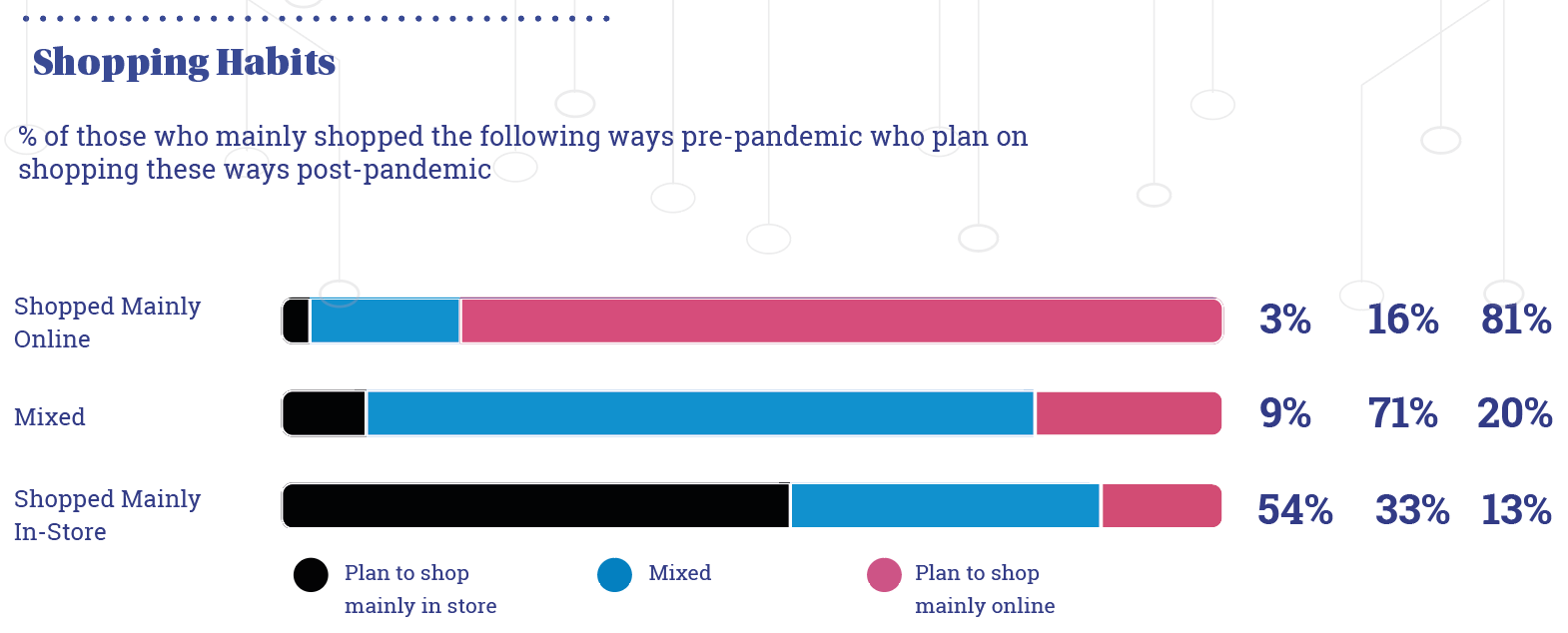To remain relevant in the changing environment, physical retail locations need to adapt by building better links between online and offline touchpoints.
ONLINE/OFFLINE BALANCE SHIFTS
Retailers grappling to understand a post-pandemic reality often come back to a fundamental question: what will be the balance of in-store vs. online shopping in the future? In a study of fashion shoppers, our insight data captured behavioural insight into how they typically shopped for apparel and accessories, as well as how they expected to shop for these items in a post pandemic marketplace.
On one of the key insights we found was that, despite a huge movement toward online shopping, in-store purchases in categories like clothing, shoes, and accessories (jewellery, handbags, etc.) remained quite strong. In certain markets, notably France, consumers reported buying more of these types of products in-store vs. online recently. e of the key insights we found was that, despite a huge movement toward online shopping, in-store purchases in categories like clothing, shoes, and accessories (jewellery, handbags, etc.) remained quite strong. In certain markets, notably France, consumers reported buying more of these types of products in-store vs. online recently.
What’s also clear from the data is that fashion buyers gravitate toward a mix of online and in-store; using one channel doesn’t lead to the exclusion of the other. For example, while 85% of U.S. consumers surveyed said they had purchased fashion items in-store, only 15% reported they had purchased items in-store only. Similarly, while 96% of Chinese buyers were purchasing goods online, just 19% said they did so exclusively online.
Looking at future shopping intent further validates this idea that consumers will continue to want a mix, but there are interesting demographic traits to consider.

THE ROLE OF IN-STORE
To remain relevant in the changing environment, physical retail locations need to adapt by building better links between online and offline touch-points. Omni-channel retail is not new; but, since the pandemic, online channels have taken on new meaning in the shopping journey, especially among countries and demographics where the biggest shifts toward digital have happened. Now is the time to reimagine omni-channel, where elements of the physical storefront connect to the online discovery, purchase, and advocacy experiences in new ways facilitated by technology.
The data has identified that fashion buyers are very receptive to solutions that improve the physical retail experience. Shoppers indicate that they want the physical retail experience to be improved through convenient, frictionless payment and delivery options. Three-quarters of fashion shoppers want retailers to offer up more solutions, with self check-out (32%), curb side pickup (26%), and mobile payment compatibility (22%) topping the list.
During the pandemic, many fashion retailers encountered logistical challenges when reconciling fulfilment between online and in-store orders, this create a clear picture of how prevalent omni-channel shopping will be looking ahead. Digital ID technologies and smart labelling of apparel and footwear are being used by innovative retailer to gain greater visibility and inventory accuracy.
Alongside this demand for fulfilment on the consumer’s terms is a desire for more digital touch-points within the store itself, especially among younger age groups. Between one-fifth and one-quarter of 16-44s in these countries say QR codes in-store providing product information or payment would improve the retail experience. This stands in contrast to older groups who place more emphasis on getting in and out of the store as quickly and safely as possible, particularly through frictionless in-store options like self-checkouts.
DIGITAL CONSUMER ENGAGEMENT
Technology benefits all stakeholders from in-store to post-purchase. How successfully these retail improvements are implemented depends on the versatility of the technology behind them. Whether it’s frictionless touch-points improving the in-store experience, or digital labels for consumer interaction post-purchase, technology solutions like QR codes, RFID, or NFC can add value for every stakeholder in the product’s lifecycle.
This is not just hypothetical, the benefits brought by this technology are important drivers of in-store footfall according to fashion consumers themselves. Over half of global shoppers surveyed said that receiving a personalised offer on their phone that they can use in-store would increase their likelihood of visiting a physical shop.
Similarly, 44% said the same thing about digital experiences in-store (such as the ability to scan a QR code for product information), and 40% said that connected/smart fitting rooms would motivate them to visit. Only 9% of shoppers were apathetic to these types of technology solutions, indicating the mass appeal that retailers can likely expect if they were to integrate more of these solutions into their infrastructure.
Looking at the results between fashion buyers who plan to shop differently following the pandemic provides some additional insight. It’s those who plan to shop mainly online that are most receptive to technology solutions that might drive them in-store. For example, 60% of predominantly online shoppers are interested in personalised mobile offers to drive them in-store vs. 48% of those who planned to mostly shop in-store to begin with.
The key message here is somewhat ironic; digitally enabled store experiences might have the most impact among the very people who physical retailers are most at risk of losing due to the pandemic. Brands and retailers must meet their customers online even if they want to get them offline.
ENGAGEMENT WITH DIGITAL ENGAGEMENT TOOLS
Comfort levels with the technology behind these digital touch-points have vastly improved thanks to the pandemic. Over the course of 2020, for example, monthly usage of QR codes rose by as much as 50% in the UK and by nearly 20% in the U.S. Mobile payment usage also became more popular, rising by 13% in the U.S. This helps explain why around 40% of fashion shoppers in these countries say they feel more comfortable using QR codes since the pandemic, with a similar proportion believing triggers like QR codes and NFC taps are easy ways of opening digital experiences.
Although these figures stand well below those seen in China, it’s worth remembering that such digital tools, in particular QR codes, have a long and established commercial history in China.

USE CASES FOR DIGITAL TOUCH-POINTS
Convenience, sustainability, and circularity are the most important motivators that encourage users to engage with digital touch-points. The research revealed that 67% of shoppers surveyed said they’d be likely to scan digital triggers related to increasing convenience, compared to 41% who said the same of digital triggers focused on personalisation.
This mirrors how important convenience and sustainability are as overall purchase drivers. Convenience, especially, is a big part of why online shopping has been so explosive. In the U.K., for example, many of the most important factors that increase people’s likelihood to buy products online are convenience-related, such as an easy returns policy (42%), next-day delivery (40%), and most significantly, free delivery (71%).
While consumers gravitate towards convenience, sustainability has become a key priority for buyers in more recent years as climate degradation worsens and issues around ethical labour come to light. Across all the global markets that were surveyed, consumers name being “eco-friendly” and being “socially responsible” as among the top initiatives they want brands to be implementing today. In Germany (58%) and France (58%), being eco-friendly came through as number one. In China, where so much of the global fashion supply chain starts, being socially responsible is the biggest concern for shoppers (33%).

The good news is that tech-enabled solutions, like QR codes, RFID, and NFC, hold a great deal of potential in bringing the fashion industry toward greater levels of sustainability and circularity, particularly when attached to the garment. These ID solutions give stakeholders instant access to information relevant to that product’s entire lifecycle, from manufacture to reselling, recycling, or disposal – all areas of huge impact when it comes to making the industry more environmentally conscious.



